MSc Medical Imaging Advanced Practice: Kolb's Model and Education
VerifiedAdded on 2022/09/14
|10
|1463
|14
Report
AI Summary
This report analyzes the application of Kolb's Experiential Learning Cycle within the context of MSc Medical Imaging Advanced Practice. The assignment focuses on demonstrating how engagement in the learning process enhances the capacity to educate and support less experienced colleagues in applying theoretical principles. The report details the four stages of Kolb's model: Concrete Experience, Reflective Observation, Abstract Conceptualization, and Active Experimentation. It provides a practical example of how the author, through active participation and reflection, improved their ability to explain complex concepts, such as the differences between MRI and CT scans, to a peer. The report concludes by emphasizing the importance of engagement in learning and its positive impact on understanding, knowledge retention, and the ability to support others within the field of medical imaging. The author highlights how active learning and collaborative discussions facilitated a deeper understanding of the material and improved the overall learning experience for all involved.
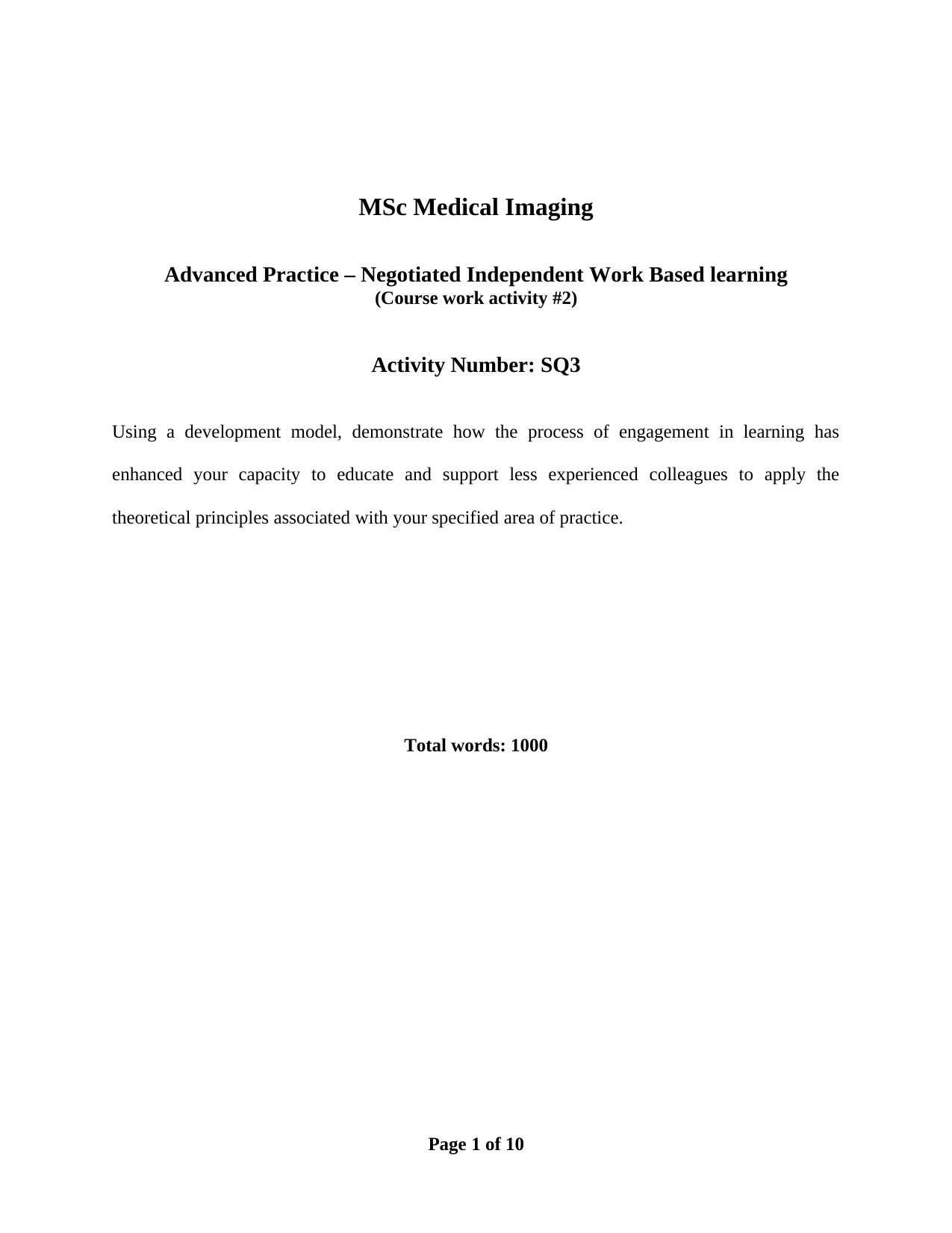
MSc Medical Imaging
Advanced Practice – Negotiated Independent Work Based learning
(Course work activity #2)
Activity Number: SQ3
Using a development model, demonstrate how the process of engagement in learning has
enhanced your capacity to educate and support less experienced colleagues to apply the
theoretical principles associated with your specified area of practice.
Total words: 1000
Page 1 of 10
Advanced Practice – Negotiated Independent Work Based learning
(Course work activity #2)
Activity Number: SQ3
Using a development model, demonstrate how the process of engagement in learning has
enhanced your capacity to educate and support less experienced colleagues to apply the
theoretical principles associated with your specified area of practice.
Total words: 1000
Page 1 of 10
Paraphrase This Document
Need a fresh take? Get an instant paraphrase of this document with our AI Paraphraser

Table of Contents
1.0 Introduction............................................................................................................................4
2.0 Kolbs Development Model....................................................................................................5
2.1 Concrete Experience...........................................................................................................6
2.2 Reflective Observation.......................................................................................................6
2.3 Abstract Conceptualization...........................................................................................6 - 7
2.4 Active Experimentation......................................................................................................7
3.0 Conclusion.............................................................................................................................8
References....................................................................................................................................9
Page 2 of 10
1.0 Introduction............................................................................................................................4
2.0 Kolbs Development Model....................................................................................................5
2.1 Concrete Experience...........................................................................................................6
2.2 Reflective Observation.......................................................................................................6
2.3 Abstract Conceptualization...........................................................................................6 - 7
2.4 Active Experimentation......................................................................................................7
3.0 Conclusion.............................................................................................................................8
References....................................................................................................................................9
Page 2 of 10
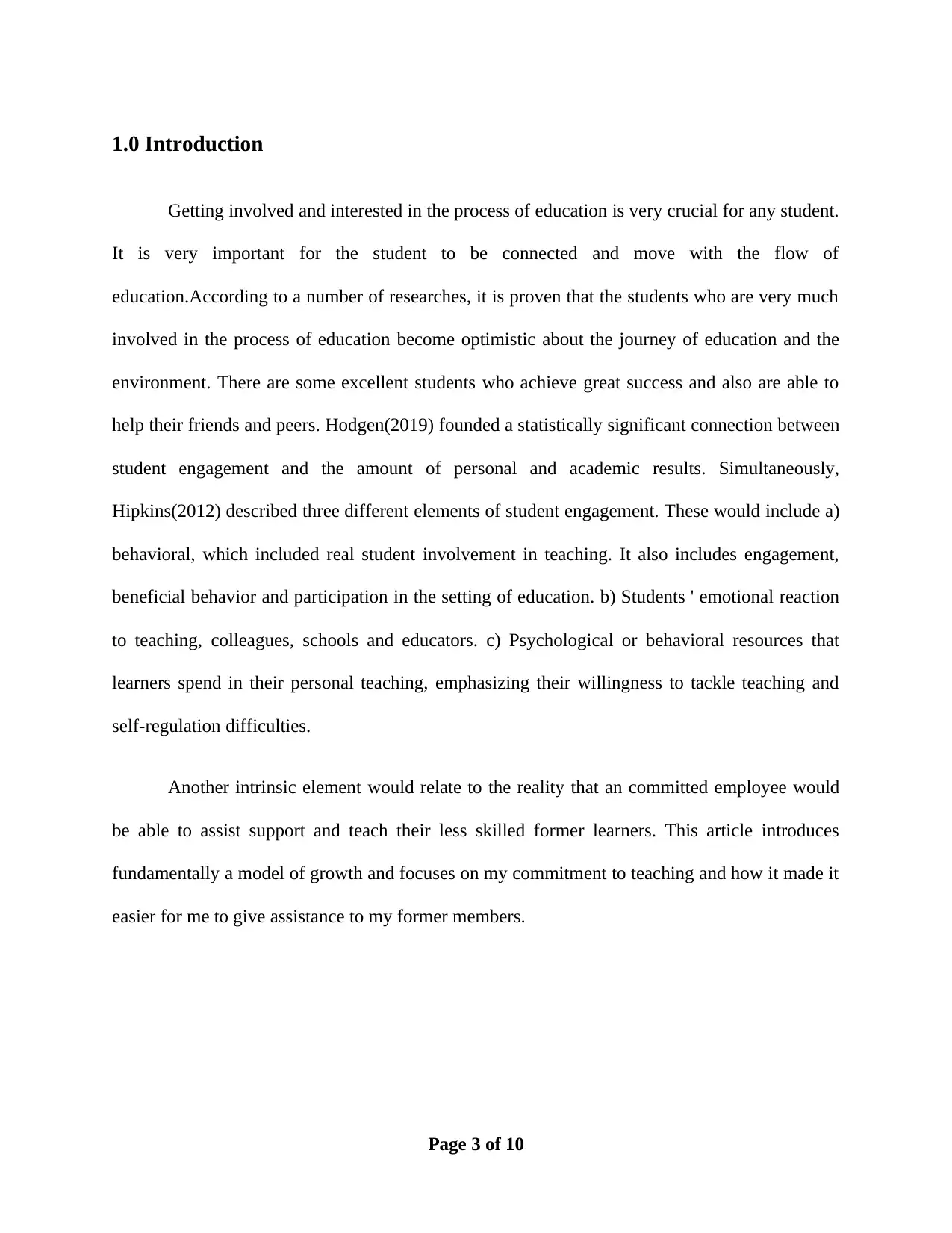
1.0 Introduction
Getting involved and interested in the process of education is very crucial for any student.
It is very important for the student to be connected and move with the flow of
education.According to a number of researches, it is proven that the students who are very much
involved in the process of education become optimistic about the journey of education and the
environment. There are some excellent students who achieve great success and also are able to
help their friends and peers. Hodgen(2019) founded a statistically significant connection between
student engagement and the amount of personal and academic results. Simultaneously,
Hipkins(2012) described three different elements of student engagement. These would include a)
behavioral, which included real student involvement in teaching. It also includes engagement,
beneficial behavior and participation in the setting of education. b) Students ' emotional reaction
to teaching, colleagues, schools and educators. c) Psychological or behavioral resources that
learners spend in their personal teaching, emphasizing their willingness to tackle teaching and
self-regulation difficulties.
Another intrinsic element would relate to the reality that an committed employee would
be able to assist support and teach their less skilled former learners. This article introduces
fundamentally a model of growth and focuses on my commitment to teaching and how it made it
easier for me to give assistance to my former members.
Page 3 of 10
Getting involved and interested in the process of education is very crucial for any student.
It is very important for the student to be connected and move with the flow of
education.According to a number of researches, it is proven that the students who are very much
involved in the process of education become optimistic about the journey of education and the
environment. There are some excellent students who achieve great success and also are able to
help their friends and peers. Hodgen(2019) founded a statistically significant connection between
student engagement and the amount of personal and academic results. Simultaneously,
Hipkins(2012) described three different elements of student engagement. These would include a)
behavioral, which included real student involvement in teaching. It also includes engagement,
beneficial behavior and participation in the setting of education. b) Students ' emotional reaction
to teaching, colleagues, schools and educators. c) Psychological or behavioral resources that
learners spend in their personal teaching, emphasizing their willingness to tackle teaching and
self-regulation difficulties.
Another intrinsic element would relate to the reality that an committed employee would
be able to assist support and teach their less skilled former learners. This article introduces
fundamentally a model of growth and focuses on my commitment to teaching and how it made it
easier for me to give assistance to my former members.
Page 3 of 10
⊘ This is a preview!⊘
Do you want full access?
Subscribe today to unlock all pages.

Trusted by 1+ million students worldwide
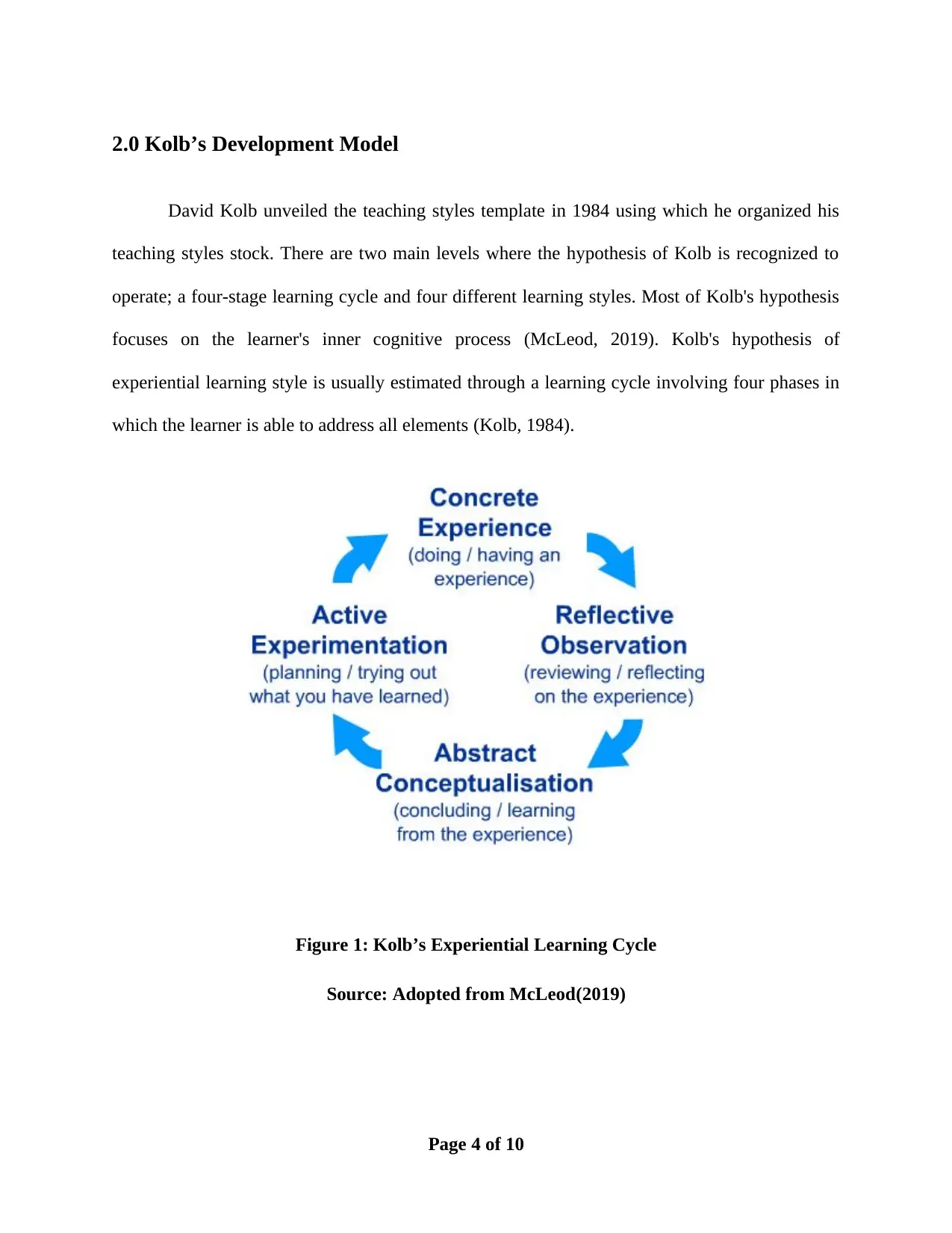
2.0 Kolb’s Development Model
David Kolb unveiled the teaching styles template in 1984 using which he organized his
teaching styles stock. There are two main levels where the hypothesis of Kolb is recognized to
operate; a four-stage learning cycle and four different learning styles. Most of Kolb's hypothesis
focuses on the learner's inner cognitive process (McLeod, 2019). Kolb's hypothesis of
experiential learning style is usually estimated through a learning cycle involving four phases in
which the learner is able to address all elements (Kolb, 1984).
Figure 1: Kolb’s Experiential Learning Cycle
Source: Adopted from McLeod(2019)
Page 4 of 10
David Kolb unveiled the teaching styles template in 1984 using which he organized his
teaching styles stock. There are two main levels where the hypothesis of Kolb is recognized to
operate; a four-stage learning cycle and four different learning styles. Most of Kolb's hypothesis
focuses on the learner's inner cognitive process (McLeod, 2019). Kolb's hypothesis of
experiential learning style is usually estimated through a learning cycle involving four phases in
which the learner is able to address all elements (Kolb, 1984).
Figure 1: Kolb’s Experiential Learning Cycle
Source: Adopted from McLeod(2019)
Page 4 of 10
Paraphrase This Document
Need a fresh take? Get an instant paraphrase of this document with our AI Paraphraser
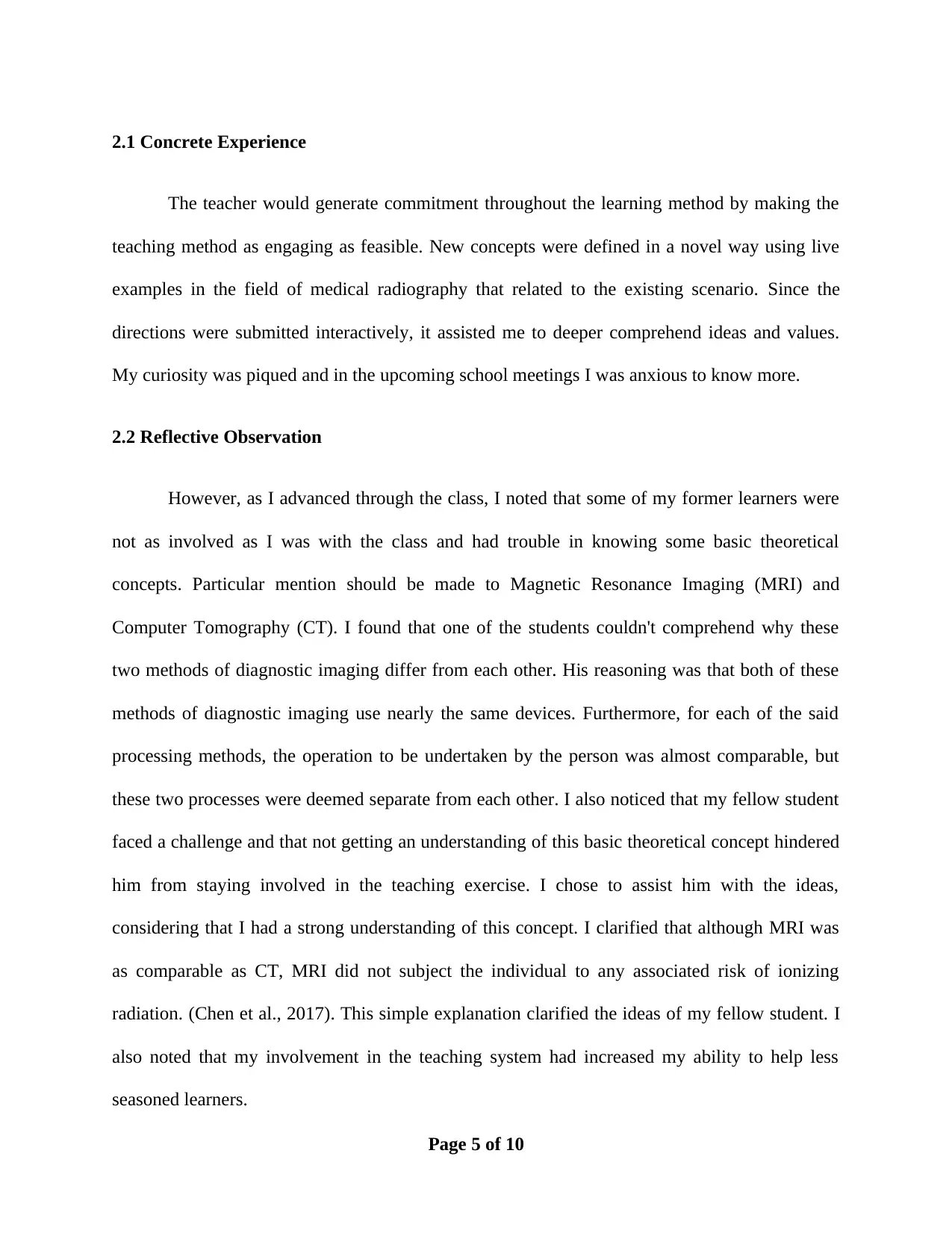
2.1 Concrete Experience
The teacher would generate commitment throughout the learning method by making the
teaching method as engaging as feasible. New concepts were defined in a novel way using live
examples in the field of medical radiography that related to the existing scenario. Since the
directions were submitted interactively, it assisted me to deeper comprehend ideas and values.
My curiosity was piqued and in the upcoming school meetings I was anxious to know more.
2.2 Reflective Observation
However, as I advanced through the class, I noted that some of my former learners were
not as involved as I was with the class and had trouble in knowing some basic theoretical
concepts. Particular mention should be made to Magnetic Resonance Imaging (MRI) and
Computer Tomography (CT). I found that one of the students couldn't comprehend why these
two methods of diagnostic imaging differ from each other. His reasoning was that both of these
methods of diagnostic imaging use nearly the same devices. Furthermore, for each of the said
processing methods, the operation to be undertaken by the person was almost comparable, but
these two processes were deemed separate from each other. I also noticed that my fellow student
faced a challenge and that not getting an understanding of this basic theoretical concept hindered
him from staying involved in the teaching exercise. I chose to assist him with the ideas,
considering that I had a strong understanding of this concept. I clarified that although MRI was
as comparable as CT, MRI did not subject the individual to any associated risk of ionizing
radiation. (Chen et al., 2017). This simple explanation clarified the ideas of my fellow student. I
also noted that my involvement in the teaching system had increased my ability to help less
seasoned learners.
Page 5 of 10
The teacher would generate commitment throughout the learning method by making the
teaching method as engaging as feasible. New concepts were defined in a novel way using live
examples in the field of medical radiography that related to the existing scenario. Since the
directions were submitted interactively, it assisted me to deeper comprehend ideas and values.
My curiosity was piqued and in the upcoming school meetings I was anxious to know more.
2.2 Reflective Observation
However, as I advanced through the class, I noted that some of my former learners were
not as involved as I was with the class and had trouble in knowing some basic theoretical
concepts. Particular mention should be made to Magnetic Resonance Imaging (MRI) and
Computer Tomography (CT). I found that one of the students couldn't comprehend why these
two methods of diagnostic imaging differ from each other. His reasoning was that both of these
methods of diagnostic imaging use nearly the same devices. Furthermore, for each of the said
processing methods, the operation to be undertaken by the person was almost comparable, but
these two processes were deemed separate from each other. I also noticed that my fellow student
faced a challenge and that not getting an understanding of this basic theoretical concept hindered
him from staying involved in the teaching exercise. I chose to assist him with the ideas,
considering that I had a strong understanding of this concept. I clarified that although MRI was
as comparable as CT, MRI did not subject the individual to any associated risk of ionizing
radiation. (Chen et al., 2017). This simple explanation clarified the ideas of my fellow student. I
also noted that my involvement in the teaching system had increased my ability to help less
seasoned learners.
Page 5 of 10
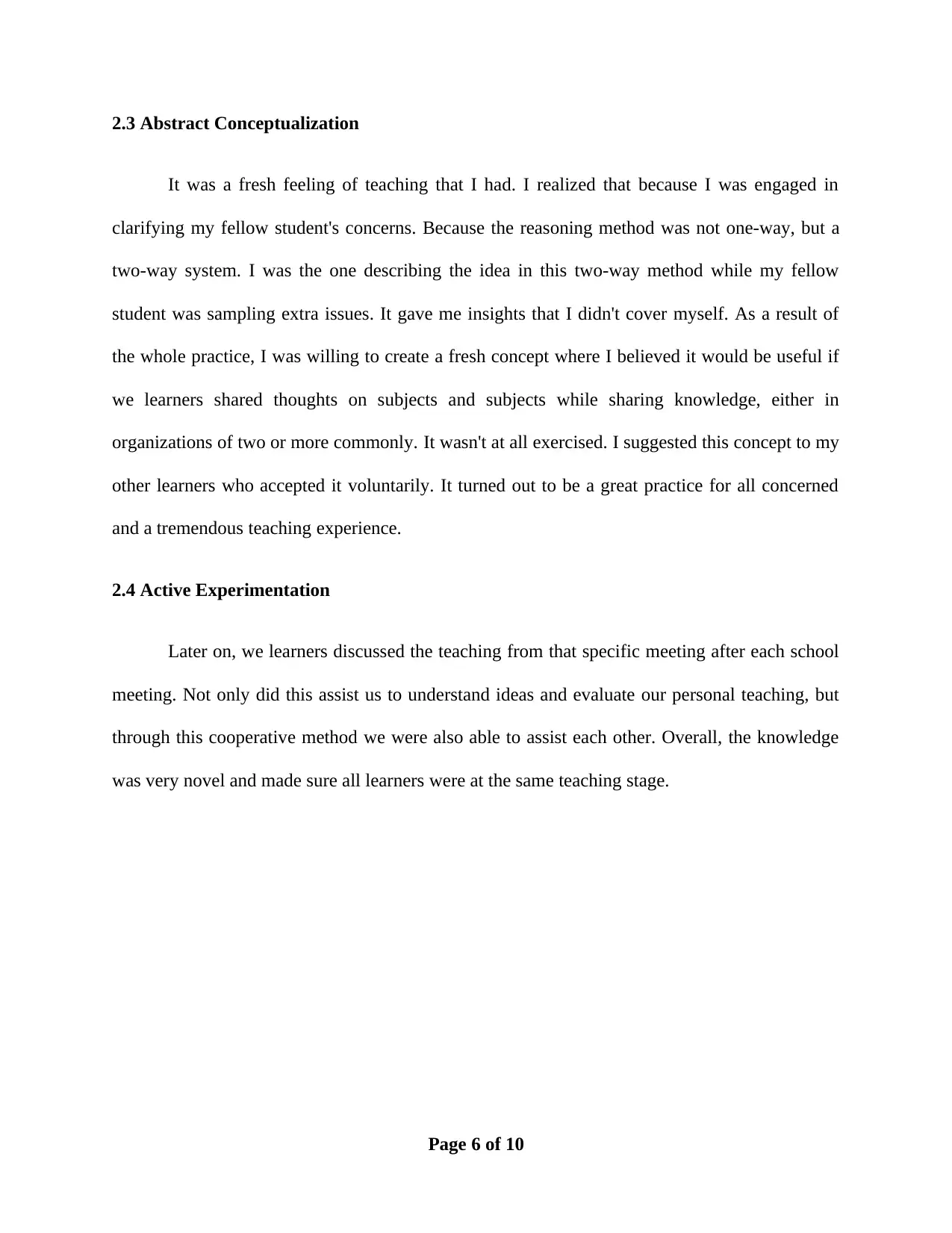
2.3 Abstract Conceptualization
It was a fresh feeling of teaching that I had. I realized that because I was engaged in
clarifying my fellow student's concerns. Because the reasoning method was not one-way, but a
two-way system. I was the one describing the idea in this two-way method while my fellow
student was sampling extra issues. It gave me insights that I didn't cover myself. As a result of
the whole practice, I was willing to create a fresh concept where I believed it would be useful if
we learners shared thoughts on subjects and subjects while sharing knowledge, either in
organizations of two or more commonly. It wasn't at all exercised. I suggested this concept to my
other learners who accepted it voluntarily. It turned out to be a great practice for all concerned
and a tremendous teaching experience.
2.4 Active Experimentation
Later on, we learners discussed the teaching from that specific meeting after each school
meeting. Not only did this assist us to understand ideas and evaluate our personal teaching, but
through this cooperative method we were also able to assist each other. Overall, the knowledge
was very novel and made sure all learners were at the same teaching stage.
Page 6 of 10
It was a fresh feeling of teaching that I had. I realized that because I was engaged in
clarifying my fellow student's concerns. Because the reasoning method was not one-way, but a
two-way system. I was the one describing the idea in this two-way method while my fellow
student was sampling extra issues. It gave me insights that I didn't cover myself. As a result of
the whole practice, I was willing to create a fresh concept where I believed it would be useful if
we learners shared thoughts on subjects and subjects while sharing knowledge, either in
organizations of two or more commonly. It wasn't at all exercised. I suggested this concept to my
other learners who accepted it voluntarily. It turned out to be a great practice for all concerned
and a tremendous teaching experience.
2.4 Active Experimentation
Later on, we learners discussed the teaching from that specific meeting after each school
meeting. Not only did this assist us to understand ideas and evaluate our personal teaching, but
through this cooperative method we were also able to assist each other. Overall, the knowledge
was very novel and made sure all learners were at the same teaching stage.
Page 6 of 10
⊘ This is a preview!⊘
Do you want full access?
Subscribe today to unlock all pages.

Trusted by 1+ million students worldwide
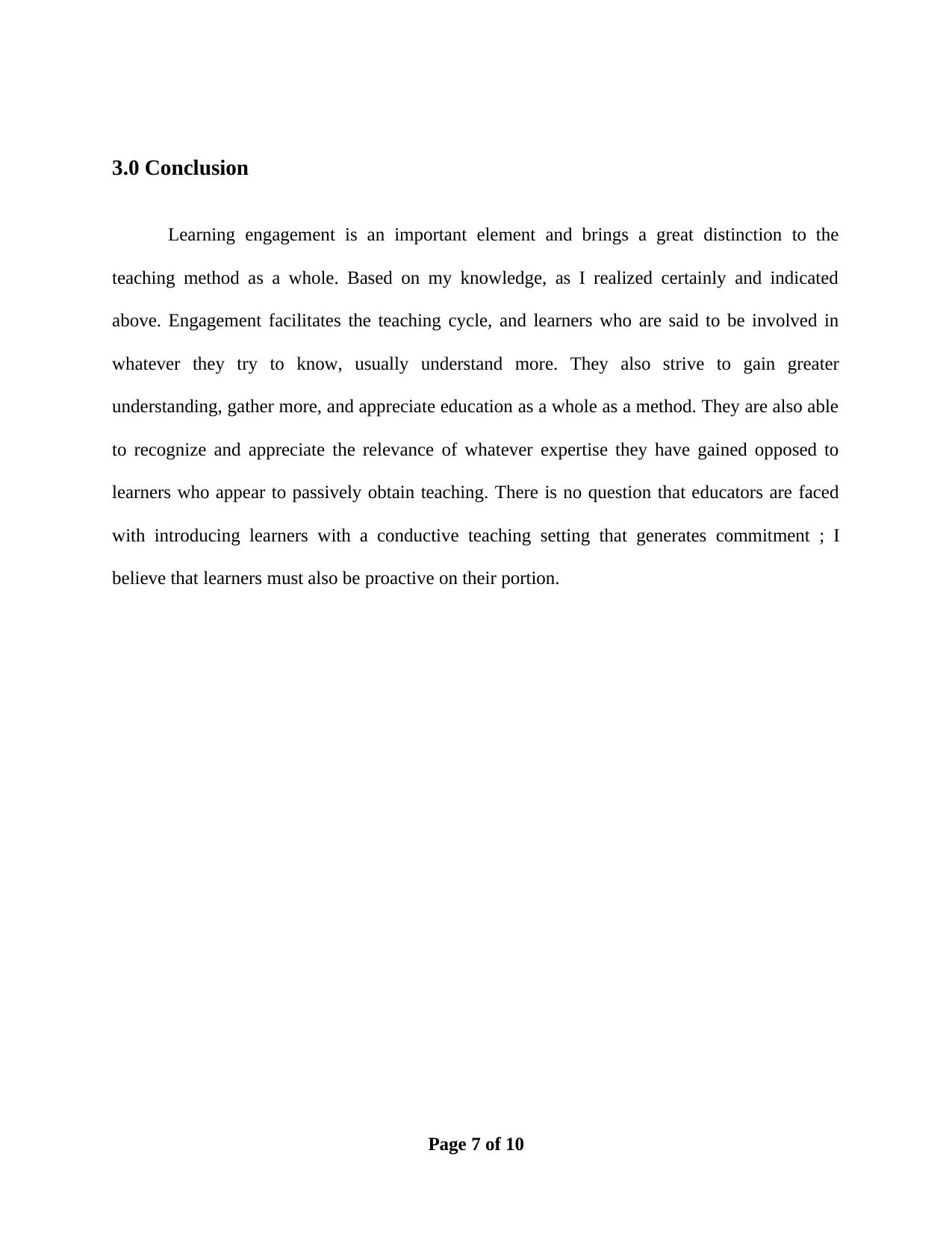
3.0 Conclusion
Learning engagement is an important element and brings a great distinction to the
teaching method as a whole. Based on my knowledge, as I realized certainly and indicated
above. Engagement facilitates the teaching cycle, and learners who are said to be involved in
whatever they try to know, usually understand more. They also strive to gain greater
understanding, gather more, and appreciate education as a whole as a method. They are also able
to recognize and appreciate the relevance of whatever expertise they have gained opposed to
learners who appear to passively obtain teaching. There is no question that educators are faced
with introducing learners with a conductive teaching setting that generates commitment ; I
believe that learners must also be proactive on their portion.
Page 7 of 10
Learning engagement is an important element and brings a great distinction to the
teaching method as a whole. Based on my knowledge, as I realized certainly and indicated
above. Engagement facilitates the teaching cycle, and learners who are said to be involved in
whatever they try to know, usually understand more. They also strive to gain greater
understanding, gather more, and appreciate education as a whole as a method. They are also able
to recognize and appreciate the relevance of whatever expertise they have gained opposed to
learners who appear to passively obtain teaching. There is no question that educators are faced
with introducing learners with a conductive teaching setting that generates commitment ; I
believe that learners must also be proactive on their portion.
Page 7 of 10
Paraphrase This Document
Need a fresh take? Get an instant paraphrase of this document with our AI Paraphraser
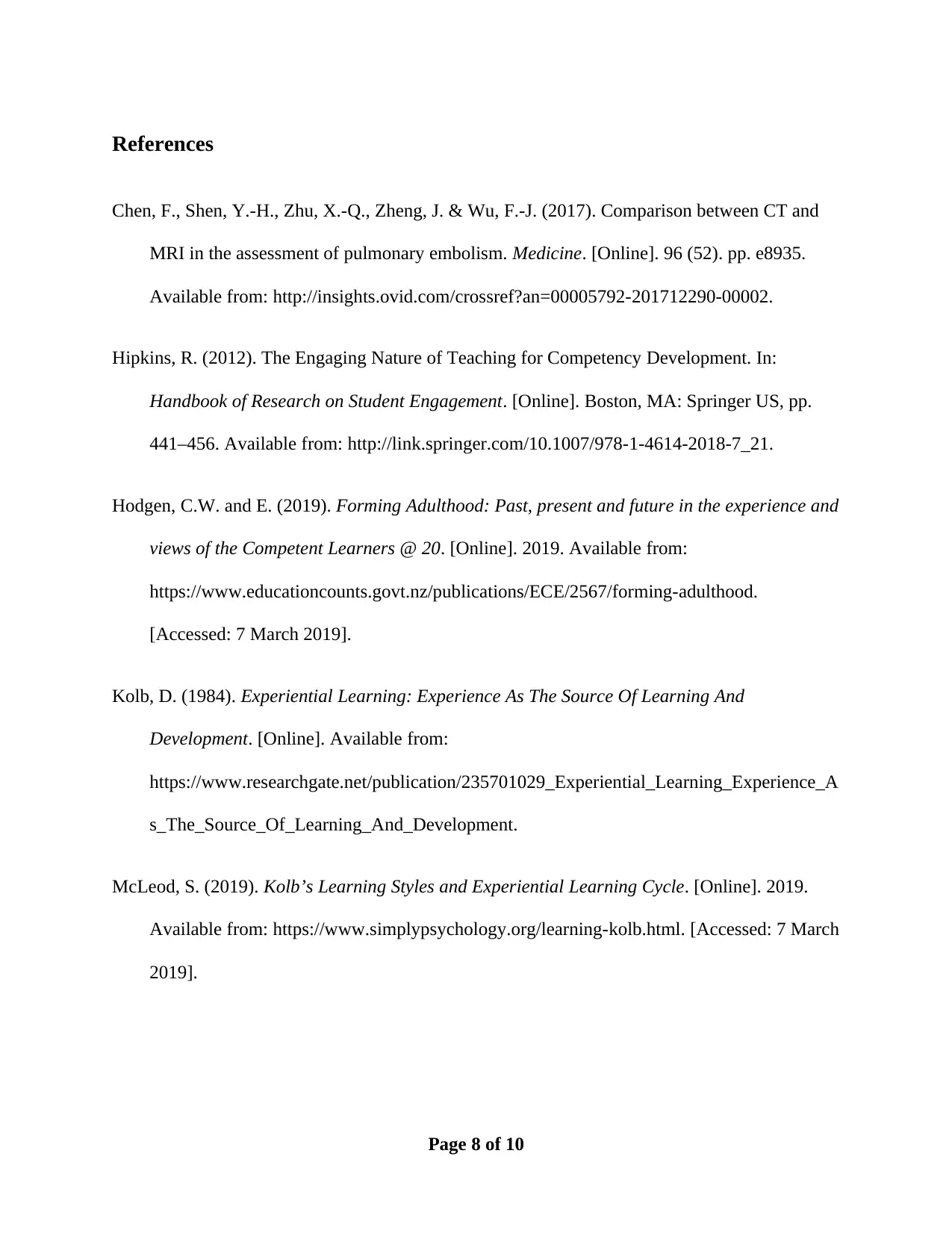
References
Chen, F., Shen, Y.-H., Zhu, X.-Q., Zheng, J. & Wu, F.-J. (2017). Comparison between CT and
MRI in the assessment of pulmonary embolism. Medicine. [Online]. 96 (52). pp. e8935.
Available from: http://insights.ovid.com/crossref?an=00005792-201712290-00002.
Hipkins, R. (2012). The Engaging Nature of Teaching for Competency Development. In:
Handbook of Research on Student Engagement. [Online]. Boston, MA: Springer US, pp.
441–456. Available from: http://link.springer.com/10.1007/978-1-4614-2018-7_21.
Hodgen, C.W. and E. (2019). Forming Adulthood: Past, present and future in the experience and
views of the Competent Learners @ 20. [Online]. 2019. Available from:
https://www.educationcounts.govt.nz/publications/ECE/2567/forming-adulthood.
[Accessed: 7 March 2019].
Kolb, D. (1984). Experiential Learning: Experience As The Source Of Learning And
Development. [Online]. Available from:
https://www.researchgate.net/publication/235701029_Experiential_Learning_Experience_A
s_The_Source_Of_Learning_And_Development.
McLeod, S. (2019). Kolb’s Learning Styles and Experiential Learning Cycle. [Online]. 2019.
Available from: https://www.simplypsychology.org/learning-kolb.html. [Accessed: 7 March
2019].
Page 8 of 10
Chen, F., Shen, Y.-H., Zhu, X.-Q., Zheng, J. & Wu, F.-J. (2017). Comparison between CT and
MRI in the assessment of pulmonary embolism. Medicine. [Online]. 96 (52). pp. e8935.
Available from: http://insights.ovid.com/crossref?an=00005792-201712290-00002.
Hipkins, R. (2012). The Engaging Nature of Teaching for Competency Development. In:
Handbook of Research on Student Engagement. [Online]. Boston, MA: Springer US, pp.
441–456. Available from: http://link.springer.com/10.1007/978-1-4614-2018-7_21.
Hodgen, C.W. and E. (2019). Forming Adulthood: Past, present and future in the experience and
views of the Competent Learners @ 20. [Online]. 2019. Available from:
https://www.educationcounts.govt.nz/publications/ECE/2567/forming-adulthood.
[Accessed: 7 March 2019].
Kolb, D. (1984). Experiential Learning: Experience As The Source Of Learning And
Development. [Online]. Available from:
https://www.researchgate.net/publication/235701029_Experiential_Learning_Experience_A
s_The_Source_Of_Learning_And_Development.
McLeod, S. (2019). Kolb’s Learning Styles and Experiential Learning Cycle. [Online]. 2019.
Available from: https://www.simplypsychology.org/learning-kolb.html. [Accessed: 7 March
2019].
Page 8 of 10
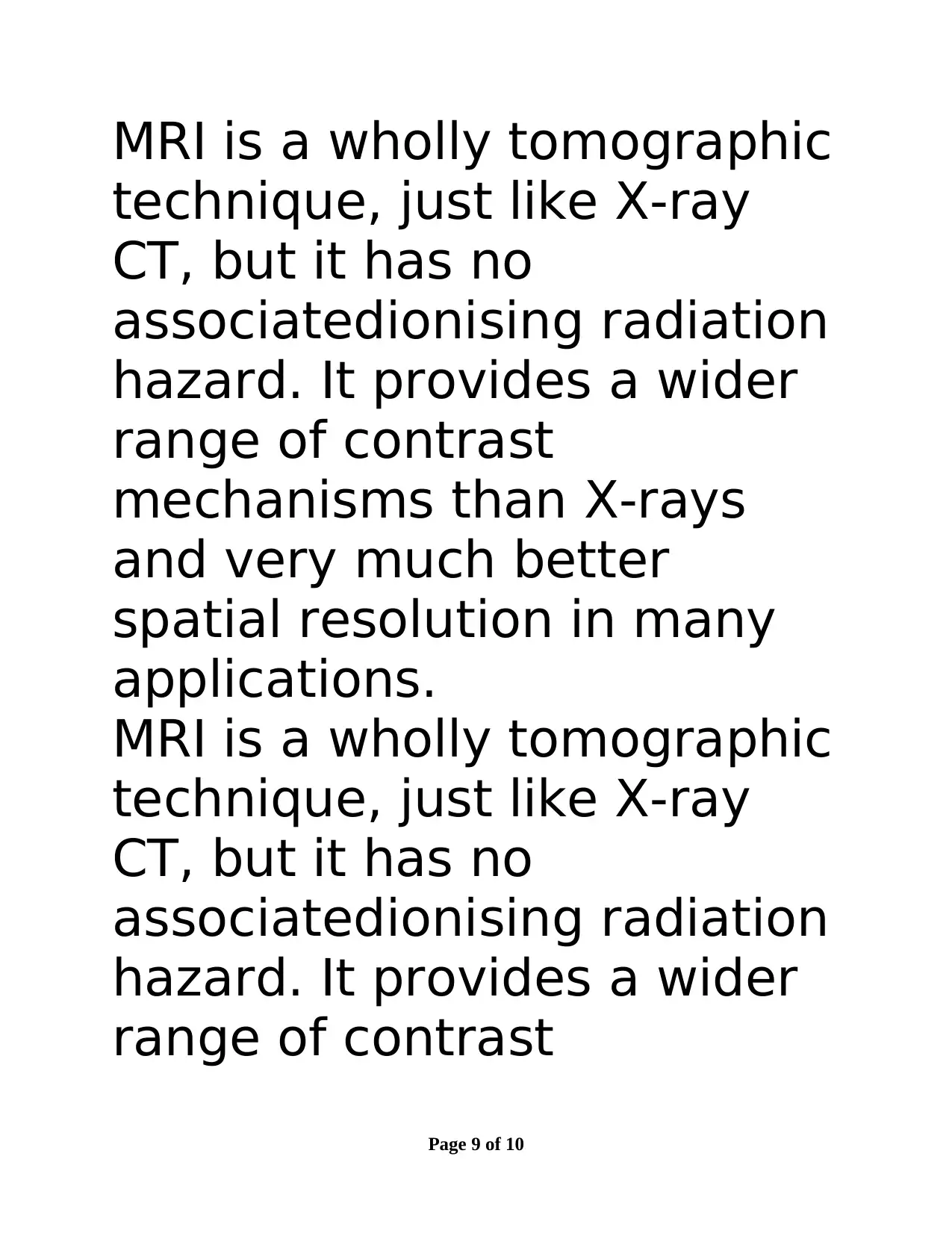
MRI is a wholly tomographic
technique, just like X-ray
CT, but it has no
associatedionising radiation
hazard. It provides a wider
range of contrast
mechanisms than X-rays
and very much better
spatial resolution in many
applications.
MRI is a wholly tomographic
technique, just like X-ray
CT, but it has no
associatedionising radiation
hazard. It provides a wider
range of contrast
Page 9 of 10
technique, just like X-ray
CT, but it has no
associatedionising radiation
hazard. It provides a wider
range of contrast
mechanisms than X-rays
and very much better
spatial resolution in many
applications.
MRI is a wholly tomographic
technique, just like X-ray
CT, but it has no
associatedionising radiation
hazard. It provides a wider
range of contrast
Page 9 of 10
⊘ This is a preview!⊘
Do you want full access?
Subscribe today to unlock all pages.

Trusted by 1+ million students worldwide

mechanisms than X-rays
and very much better
spatial resolution in many
applications.
Page 10 of 10
and very much better
spatial resolution in many
applications.
Page 10 of 10
1 out of 10
Related Documents
Your All-in-One AI-Powered Toolkit for Academic Success.
+13062052269
info@desklib.com
Available 24*7 on WhatsApp / Email
![[object Object]](/_next/static/media/star-bottom.7253800d.svg)
Unlock your academic potential
Copyright © 2020–2025 A2Z Services. All Rights Reserved. Developed and managed by ZUCOL.





